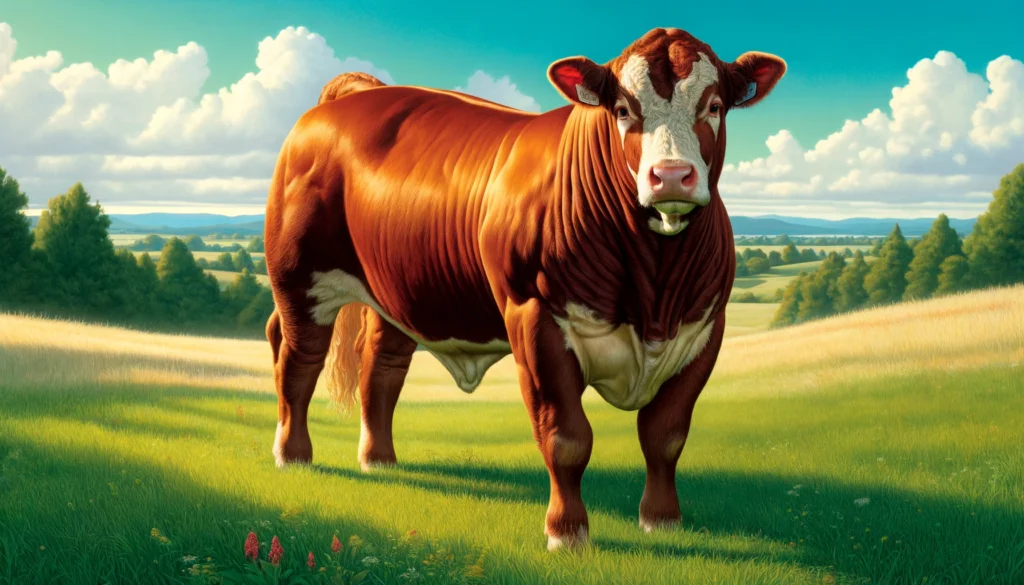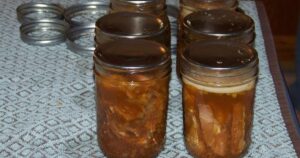
Agriculture Dictionary A vivid and detailed illustration of a Hereford steer standing in a green pasture. The Hereford has a reddish brown coat with a white face and a stock.webp.webp

Definition: Steer
A steer is a male cattle that has been castrated before reaching sexual maturity. Steers are primarily raised for beef production, as castration helps manage their behavior, making them less aggressive and easier to handle compared to intact males (bulls).
In-Depth Analysis and Applications
- Purpose and Importance: Steers are vital to the beef industry. Castration is performed to improve meat quality and manage the behavior of male cattle. Steers are preferred in beef production due to their more docile nature and the resulting meat, which is often more tender and marbled compared to that from bulls.
- Castration Methods: Castration can be performed using several methods, including surgical removal of the testicles, banding (using a tight band to cut off blood supply), and chemical castration. The choice of method depends on the age of the animal and farm management practices. Regardless of the method, it is essential to ensure humane handling and proper veterinary care to minimize stress and pain.
- Growth and Development: Steers grow rapidly and efficiently convert feed into muscle. Their growth patterns are monitored to ensure optimal weight gain and meat quality. Nutrition plays a crucial role, with steers being fed high-quality forage, grains, and supplements to meet their dietary needs. Proper feeding strategies enhance growth rates and improve the final product’s quality.
- Behavior and Management: Steers are generally more manageable than bulls due to reduced testosterone levels. They exhibit less aggressive behavior and are easier to handle in large groups. Effective management practices, including regular health checks, vaccinations, and proper housing, are essential for maintaining their health and productivity.
- Economic Significance: Steers represent a significant portion of the beef industry. Their meat is highly valued for its tenderness and flavor. The economic viability of raising steers depends on factors such as feed costs, market prices for beef, and overall farm management efficiency. Steers are often sold at auction or directly to processors, contributing to the rural economy.
- Environmental Impact: Raising steers has environmental implications, including greenhouse gas emissions, land use, and water consumption. Sustainable practices, such as rotational grazing and improved feed efficiency, are being implemented to mitigate these impacts. Advances in breeding and nutrition also aim to reduce the environmental footprint of beef production.
- Health and Veterinary Care: Steers require regular veterinary care to prevent diseases and ensure optimal growth. Common health issues include respiratory infections, digestive disorders, and parasitic infestations. Preventive measures, such as vaccinations and deworming, along with prompt treatment of illnesses, are essential for maintaining herd health.
- Meat Production: Steers are raised specifically for their meat, which is processed into various beef products, including steaks, roasts, and ground beef. The quality of beef from steers is often superior due to better marbling and tenderness. Meat quality is influenced by factors such as genetics, diet, and stress levels during rearing and slaughter.
- Cultural and Societal Roles: Steers hold cultural significance in many societies, particularly in rural and agricultural communities. They are featured in traditional events, such as rodeos and agricultural fairs, and symbolize the importance of livestock in food production. In some cultures, steer raising is a rite of passage and an essential aspect of rural life.
- Challenges and Future Directions:
- Sustainability: Developing sustainable practices for raising steers is crucial for the future of beef production. This includes reducing environmental impacts and improving animal welfare.
- Health Management: Advances in veterinary care and disease prevention are essential for maintaining healthy steer populations.
- Genetic Improvement: Continued focus on genetic selection for traits such as growth efficiency, disease resistance, and meat quality is important.
- Market Dynamics: The economic viability of raising steers depends on market conditions, including demand for beef and the costs of feed and healthcare.
- Industry Trends:
- Precision Farming: The use of technology to monitor and manage steer health and growth is increasing.
- Genomics: Advances in genomics are improving the selection process for breeding steers with desirable traits.
- Welfare Standards: Enhanced animal welfare standards and practices are becoming more prevalent, driven by consumer demand and regulatory requirements.
- Global Trade: The trade of beef and genetic material across borders is contributing to global improvement in beef production.
Resources for Further Exploration:

Originally posted 2024-06-11 03:03:54.
Fall off the barn roof and busted your keister? Life on the farm or ranch can be tough on the bum. Need a break? Laugh it off at FarmerCowboy.com, the #1 farm humor site. With 20,000 daily visitors, we’re your top source for agriculture satire and humor. Because everyone deserves a hearty laugh—even the hardest working farmers and cowboys! Join us and turn those long days into fun tales at FarmerCowboy.com.
Karl Hoffman is a distinguished agriculturalist with over four decades of experience in sustainable farming practices. He holds a Ph.D. in Agronomy from Cornell University and has made significant contributions as a professor at Iowa State University. Hoffman’s groundbreaking research on integrated pest management and soil health has revolutionized modern agriculture. As a respected farm journalist, his column “Field Notes with Karl Hoffman” and his blog “The Modern Farmer” provide insightful, practical advice to a global audience. Hoffman’s work with the USDA and the United Nations FAO has enhanced food security worldwide. His awards include the USDA’s Distinguished Service Award and the World Food Prize, reflecting his profound impact on agriculture and sustainability.






